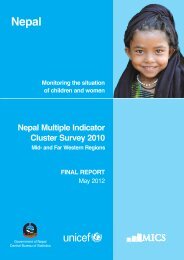Small Area Estimation of Poverty
Small Area Estimation of Poverty
Small Area Estimation of Poverty
- No tags were found...
Create successful ePaper yourself
Turn your PDF publications into a flip-book with our unique Google optimized e-Paper software.
3. Data sources and description3.1 NLSS3 and 2010/11 Population CensusThe Nepal Living Standards Survey 2010/11 (henceforth- NLSS III) is the third round <strong>of</strong> its kind conducted inNepal (the first having been fielded in 1995/96) andfollows the general structure <strong>of</strong> the World Bank’s LivingStandard Measurement Study (LSMS) surveys. It isan integrated survey covering a wide range <strong>of</strong> topicsranging from consumption expenditure to agriculturalproduction, education and remittances. It is based onthe 2000 Population Census sample frame. In the firstsampling stage, 800 Primary Sampling Units that areidentical to those in the 2007/08 National Labor ForceSurvey are selected. They fall into six strata 5 . In thesecond-stage, 500 <strong>of</strong> these PSU’s were selected with anexplicit sub-stratification that culminates in the 14 strata<strong>of</strong> the NLSS III 6 . This selection was done proportionalto size - using the number <strong>of</strong> households as a measure<strong>of</strong> size. Finally, 12 households per PSU were selectedrandomly 7 . Sampling weights have been calculated asthe inverse <strong>of</strong> the primary sampling unit’s probability<strong>of</strong> being selected. Note that the probability <strong>of</strong> beingselected, and thus the sampling weight, is based onthe sample frame <strong>of</strong> the 2000 Population Census aswell as forecasts <strong>of</strong> the population size in 2010/11.NLSS3 finally includes 5,988 households and 28,474individuals.The second data source used to produce small-areaestimates <strong>of</strong> welfare is the Nepal Population Census2011. The National Planning Commission and CentralBureau <strong>of</strong> Statistics were very supportive to providecensus data at unit level for all common variableswith the NLSS III. The number <strong>of</strong> non-institutionalhouseholds is 5,423,297. After dropping those that hada missing level <strong>of</strong> education <strong>of</strong> the household head, weend up with a dataset <strong>of</strong> 5,337,972 households.Auxiliary data sources include VDC-level GISinformation obtained from the Vulnerability Analysisand Mapping unit <strong>of</strong> World Food Program Nepal.Variables are: mean elevation in kilometers, meanslope in percentage, height range, standard deviation<strong>of</strong> height, population density in inhabitants per squarekilometer, distance to the district headquarters, length<strong>of</strong> road in kilometers (by ilaka), length <strong>of</strong> road inkilometers per thousand inhabitants (by ilaka), length<strong>of</strong> rivers in kilometers (a more detailed description canbe found in CBS et al, 2006). This information dates backto 2006, but since most variables don’t change (rapidly)over time they are still useful for the analysis in thisreport. However, as we expect that accessibility is aparticularly important indicator for welfare, we addedanother variable called “Kosh”. The CBS prepared thisvariable at the VDC level, and it measures how manyhours it takes for a normal person to walk from theVDC to the district headquarters.3.2 Common and comparable variablesTable A1 in Appendix I (<strong>of</strong> the main document)presents the mean, minimum, maximum, and standarddeviation <strong>of</strong> common variables between the survey andthe census. As the census enumeration was done in June2011 closely on the heels <strong>of</strong> the survey (February 2010 toFebruary 2011), one would expect very little variationbetween both data sources. Yet, we find that for a number<strong>of</strong> household-level variables the census mean does notlie within two standard errors <strong>of</strong> the survey, i.e. they arestatistically different. One potential explanation for thisis that the Census is conducted four months after theSurvey, a time lapse <strong>of</strong> 10 months from the mid-point <strong>of</strong>theone year survey period and the census date. If overthe span <strong>of</strong> that short period the Nepali population hasbecome better <strong>of</strong>f in terms <strong>of</strong> some major indicators,such as the construction material <strong>of</strong> their homes orthe level <strong>of</strong> education <strong>of</strong> the household head, then thiscould be a reasonable explanation. Alternatively, thedifference could be attributed to misrepresentation<strong>of</strong> the population in the NLSS III household survey.Population weights convert the survey sample to strataleveland nationally representative numbers, but theyare based on a forecast <strong>of</strong> the 2010 population made in2001. However, even after adjusting the weights basedon the actual 2011 Census population, the survey andcensus means <strong>of</strong> the majority <strong>of</strong> the common variablesstill don’t line up. Alongside these household-levelvariables, Census means on the level <strong>of</strong> the ward and5 These 5 strata are: Mountains; Urban Kathmandu, Other urban in hills, Other urban in terai, Rural hills, Rural terai6 These 14 strata are: Mountains, Urban Kathmandu, Other urban in hills, Rural eastern hills, Rural central hills, Rural western hills, Rural midwestern hills, Ruralfarwestern hills, Urban terai, Rural east terai, Rural central terai, Rural western terai, Rural midwestern terai, Rural farwestern terai.7 For more details on sample design see NLSS III Statistical Report, volume 1, Central Bureau <strong>of</strong> Statistics.4 NEPAL <strong>Small</strong> <strong>Area</strong> <strong>Estimation</strong> <strong>of</strong> <strong>Poverty</strong>, 2011, Summary and Major Findings
















